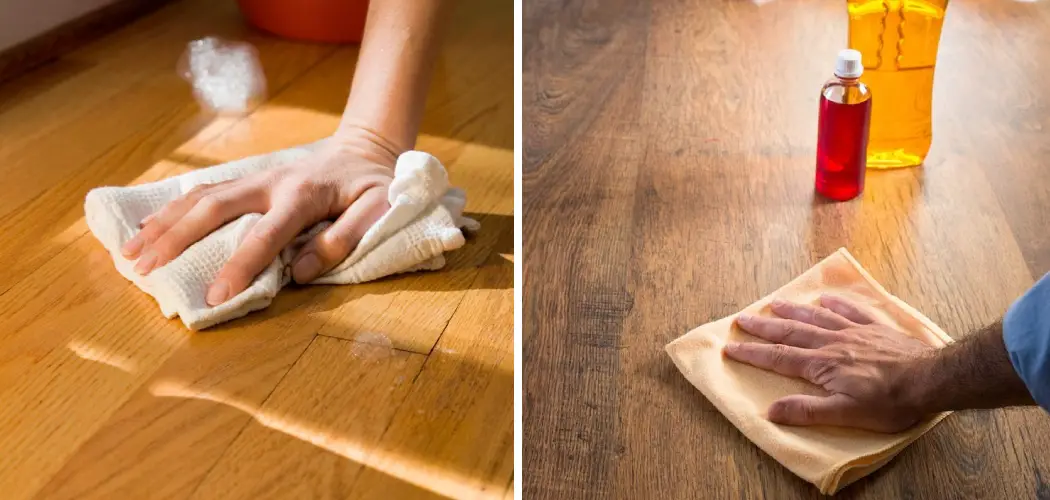Wood flooring is a timeless, classic look that adds elegance to any home. It can increase the value of your house and add warmth and beauty to your living space. But accidents happen, and it’s not unusual for wood floors to become stained or discolored over time. Fortunately, learning to get stains off wood floors is possible, and you can use several techniques to return your floors to their former glory.
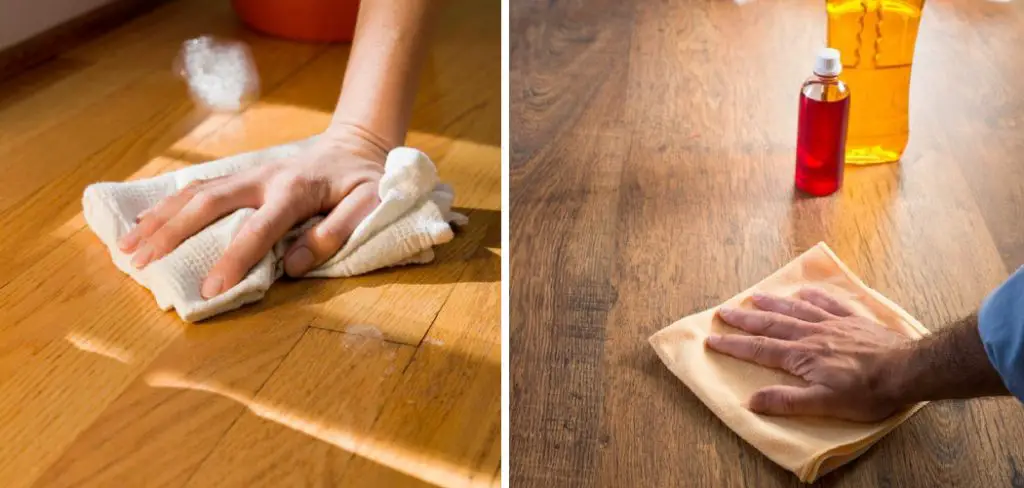
One of the great advantages of getting stains off wood floors is that it is easy and straightforward. For example, if you have a water stain on your wood floor, you only need to use warm water and mild dish soap solution and mop with a soft cloth.
This will help remove the discoloration without damaging the wood. You may want to use a wood floor cleaner and polish for deeper stains. In this blog post, You will learn in detail how to get stains off wood floor.
Causes of How to Get Stains Off Wood Floor
- Water: If water has been spilled on the wood, the stain will usually be easy to remove with a damp cloth or sponge. However, too much water can damage the wood and cause discoloration, warping, and staining.
- Oil: Oil stains are some of the most difficult to remove from a wood floor. Depending on the type of oil, a specific solvent must be used to get rid of the stain.
- Food: Spills from food and beverages like coffee or tea can leave behind dark stains. To remove them, create an equal parts mixture of white vinegar and water and apply it directly to the stain with a cloth.
- Ink: To remove an ink stain from a wood floor, you can use isopropyl alcohol or denatured alcohol to dissolve the stain. Ensure not to apply too much liquid, as it can damage the wood.
- Dirt and Mud: These types of stains are easy to clean with a damp cloth. Use a mild cleaner to help remove any dirt or mud that may still be present.
- Blood: To remove a blood stain from wood, apply hydrogen peroxide directly onto the stained area with a cotton swab or cotton ball. Allow the solution to sit for several minutes before wiping it away with a clean cloth. Be sure to use a gentle cleaner, as harsh chemicals can further damage the wood.
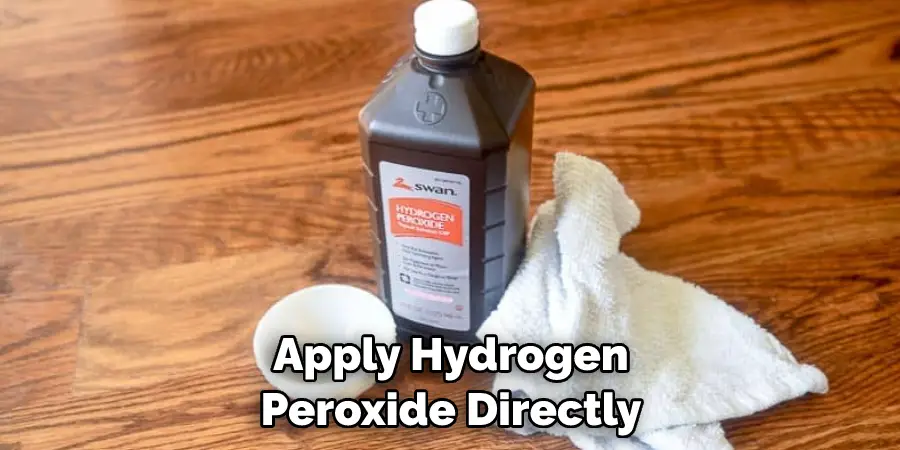
Step-by-step Instructions for How to Get Stains Off Wood Floor
Step 1: Inspect the Stain
Before attempting to clean the stain, it is important to assess the type of stain and whether or not it has already set in. If the stain is fresh and still wet, you should use a dry cloth or paper towel to absorb as much liquid as possible before proceeding.
Step 2: Vacuum the Floor
Use your vacuum cleaner with an upholstery attachment to remove any dirt, dust or debris that may be sitting on top of the stain. Taking this step ensures a better cleaning solution and prevents the spreading of the stain.
Step 3: Select Your Cleaning Solution
Depending on the type of stain, there are several different types of cleaning products that can be used. For example, a mix of water and dish soap can be used for food or grease-based stains. A vinegar and water solution is effective for organic stains like wine, coffee, or tea, while the white spirit is good for removing ink or paint-based stains.
Step 4: Apply the Cleaning Solution
You should always apply your chosen cleaning product to a cloth or soft brush and then onto the stained area. This is to ensure a controlled application of the product and prevents it from spreading to other areas of the flooring.
Step 5: Gently Rub Away the Stain
Once you have applied your cleaning solution, use a circular motion with your cloth or soft brush and gently rub away the stain. Don’t scrub too hard, as this can cause further damage to the wood flooring. Using a dry cloth, remove any excess cleaning solution from the stained and surrounding areas.
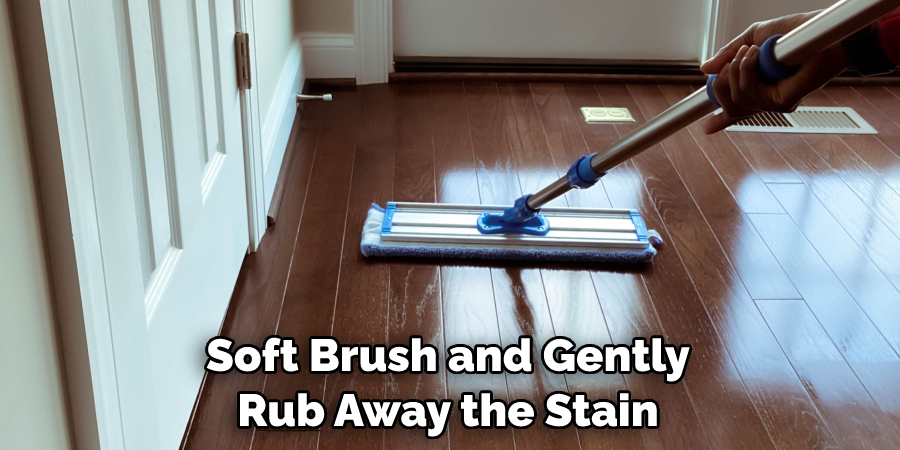
Step 6: Rinse With Water
Once you have wiped away all of the cleaning solutions, take a clean cloth dampened with water and gently wipe over the area. This will help to remove any remaining residue from the cleaning product. Using another dry cloth, carefully remove excess water from the stained and surrounding areas.
Step 7: Dry the Area
Take another dry cloth and gently pat the area to absorb any remaining moisture. Depending on the severity of the stain, you may need to repeat these steps multiple times until it is completely gone. It is important to be patient and take your time cleaning wood flooring to avoid any damage.
By being mindful of the type of cleaning solution used and taking the time to remove stains gently, you can ensure that your wood floor remains in a beautiful condition for years to come.
Safety Tips for How to Get Stains Off Wood Floor
- Before getting started, put on protective gloves and safety goggles to protect your skin and eyes from harsh chemicals or irritants.
- Test all cleaning solutions or products in an inconspicuous area of the floor first before applying it to the stained area to ensure that it is safe for use on the wood flooring.
- Avoid using too much water while cleaning to prevent damage or discoloration to the wood flooring.
- Do not use abrasive materials, such as steel wool or scouring pads, when cleaning stained wood floors, as it may cause scratches and damage the finish of the wood.
- Regularly check for any loose or broken boards and any nails that may have become exposed, and repair them if needed.
- Dry the wood flooring thoroughly after cleaning to prevent water damage. It is best to use a soft cloth when wiping down the flooring instead of a mop or other tools when possible.
These safety tips can help keep your wood flooring looking new for many years. With the right cleaning products and methods, it is possible to get rid of stubborn stains and dirt from your wood flooring with minimal effort.
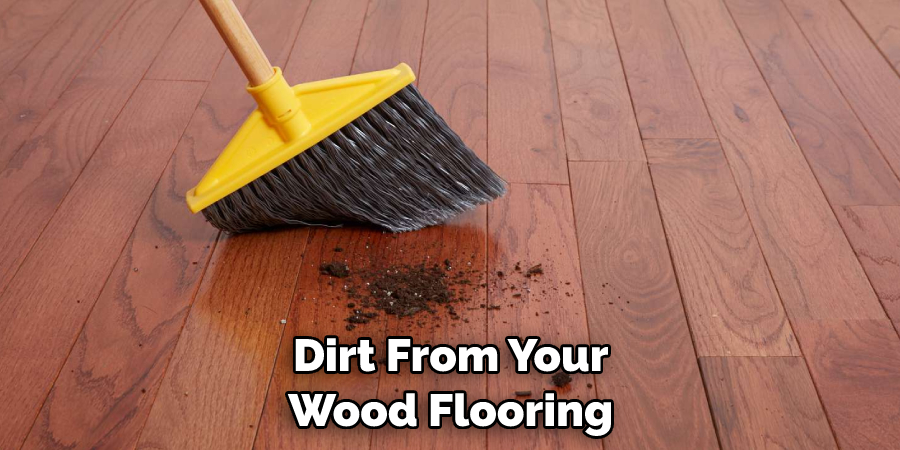
Importance of How to Get Stains Off Wood Floor
- Keeps Floors Looking Clean and New: Regular cleaning of wood floors helps to prevent deep dirt from accumulating and staining the surface. It also helps to maintain their finished look, making them look just as good as the day they were installed.
- Increases Durability: Regularly removing stains from wood floors extends their life and helps them last longer. This is because dirt and stains can settle in the wood, making it less sturdy when walked upon or potentially damaging its finish.
- Prevents Damage: Removing spills promptly prevents them from becoming deep-set stains on the wood surface. Not only are these unsightly, but if allowed to remain, they can damage the wood over time.
- Reduces Allergens: Removing dirt and stains from a wood floor helps to reduce house dust mites and other allergens that often accumulate on these surfaces. This is especially important for people who suffer from allergies or asthma.
- Improves Air Quality: Wood floors are known to trap and hold dust particles, smoke, pet dander, and other contaminants. Regularly cleaning wood floors help remove these pollutants from the home environment, which can improve air quality.
- Enhances Overall Home Value: Wood flooring is a valuable asset in any home, and its condition can have an impact on its overall value. Regularly cleaning and properly maintaining wood floors will help maintain their value and enhance the home’s overall resale value.
Taking these steps to clean and maintain a wood floor is essential for anyone looking to keep their floors looking great for years to come.
How Do You Best Protect Your Wood Floor From Future Staining?
Once you have cleaned your wood floor and removed any stains, it is important to take steps to protect it from future staining. Sealants are a great way to protect the wood surface from dirt, dust, grease, and oil that could potentially lead to staining.
A polyurethane or varnish sealant should be applied before exposing the floor to any liquids. Additionally, rugs and mats should be placed at all your home’s entrance points as they act like a barrier between the wood and dirt or liquid that might be tracked in.
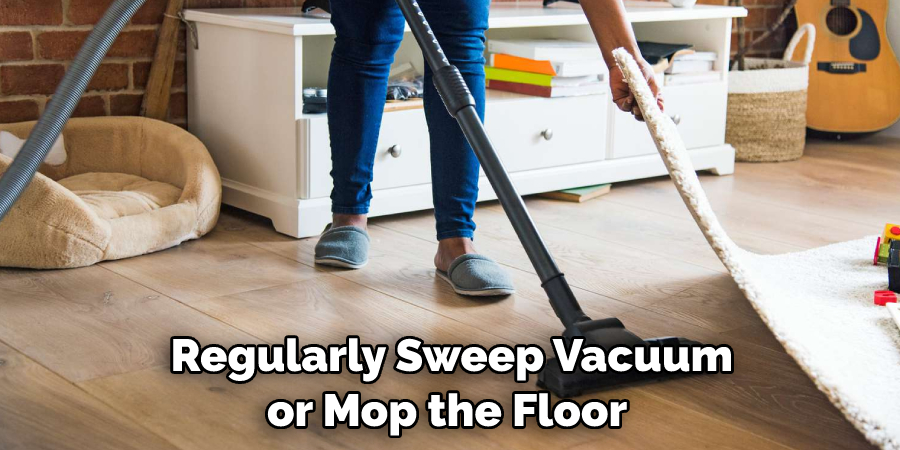
It is important to regularly sweep, vacuum, or mop the floor so any debris or dust particles are removed routinely in order to avoid staining. By maintaining your wood floor and taking preventive steps, you can ensure it will look great for years to come. Another tip is to use a cleaning solution designed specifically for wood floors.
Many products on the market are actually too harsh for wood floors and could cause discoloration, scratching, or dulling of the surface. A mild pH-neutral soap and water solution is usually enough to clean the floor without damaging it.
What Are the Possible Consequences of Using Too Much Water on Your Wood Floor?
Using too much water on a wood floor can cause damage, such as swelling, warping, buckling, and mold growth. Swelling is an excessive increase in the size of your wood floor caused by too much moisture penetrating its surface. Warping is when the planks of your wood floor become curved due to uneven absorption of moisture.
Buckling is when your wood floor planks move from their original position and become displaced due to uneven absorption of moisture. Mold growth can occur if too much water accumulates under the floor, creating an environment for mold spores to grow.
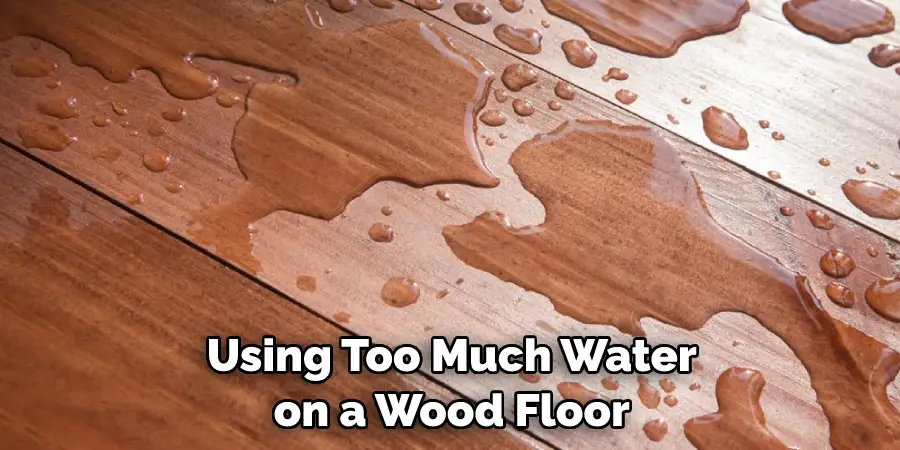
If you use too much water on your wood floor, addressing any issues that might arise as soon as possible is important to avoid any permanent damage. Cleaning up any excess water with a dry cloth and allowing the floor to air dry can help reduce the risk of damaging your wood floor. Additionally, using a dehumidifier to reduce the moisture in the room may also help prevent further water damage.
What Are the Best Methods for Removing Wax and Other Residue From a Wood Floor?
When it comes to removing wax and other residue from a wood floor, the best methods depend on how long the substance has been there and what type of surface is affected. For instance, if you need to remove wax buildup from an unfinished hardwood floor, start by scraping off as much of the wax as possible using a plastic scraper or putty knife.
Then, dampen a cloth with hot water and white vinegar solution (1 part vinegar to 2 parts water) and gently scrub the affected area in circular motions.
For a polyurethane-sealed wood floor, you will need to take extra caution as these types of surfaces can be damaged easily. Start by cleaning the surface with a vacuum cleaner to remove any loose particles. Then, make a mixture of 1 part white vinegar and two parts warm water and apply it to the affected area using a soft cloth or mop. Use circular motions to clean the floor until all residue has been removed gently.
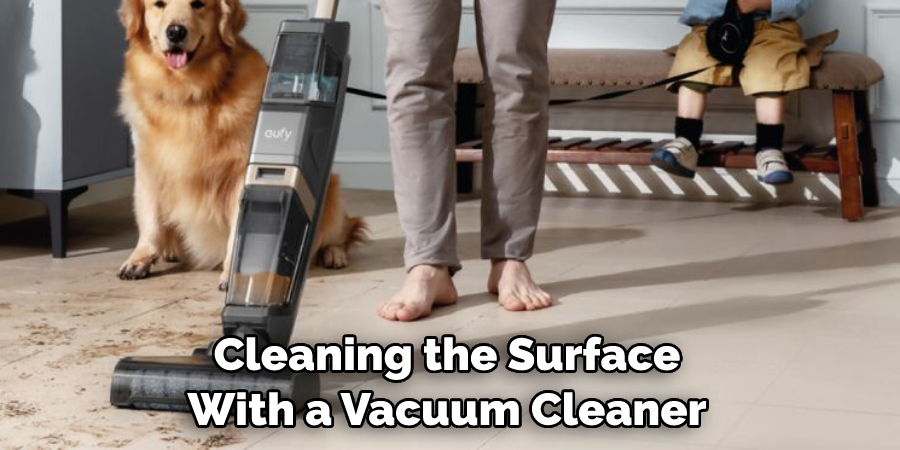
Conclusion
In conclusion, keeping your wood floors clean and free of stains is important. Learning the correct methods and products for cleaning will help ensure that your floors look their best. The most important steps are using a dry cloth or broom to remove dirt and debris, avoiding water or harsh chemicals on wood floors, using a safe cleaner to remove spots and stains, and finishing with a wood-safe wax or sealer.
With regular cleaning and maintenance, your wood floors will remain beautiful for years to come. I hope this article has been beneficial for learning how to get stains off wood floor. Make Sure the precautionary measures are followed chronologically.

